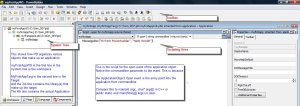Interpreted or Compiled
From that list of examples I had, there is one thing that stands out. PB looks a lot more like C/C++/Java, at least in commenting style. But, then we see it has the simplicity of Basic program that it's usually thought of as originating from. It also has a lot of similarities with Visual Basic (For that matter with other flavors of BASIC such Power basic as well). PB is actually the tool and it uses proprietary language called PowerScript. Like BASIC this is an interpreted language, but not interactive (In a BASIC interpreter, results were displayed as soon as you type a command (or a command block) and press ENTER.). In PB, though the code is interpreted, it's not the original code that you typed in, but an intermediate code it generated when you compiled (generated) or ran. More on this below.
Object Orientedness:
PB is at the very least, an Object based language. Windows environment contains windows with several controls or widgets on each window. The various controls and windows (objects) talk to each other through events and methods (functions). Now, this itself doesn't make it object oriented, but definitely object based. In PB (as in VB) an application is made up of several objects such as Application, Windows, Buttons, Text Boxes (and Data windows - more on this later). You cannot have a program without an application and you cannot communicate with the users without windows or buttons. So essentially when we build a PB application, we are reusing these "objects" as templates to make our own objects. Thus, by the very nature PB is Object based.
Real Object orientation came to it in later versions. A rudimentary "user object " was introduced as early as ver 3.0 and by Ver 5.0 Pb introduced Object-oriented concepts such as function overloading. Many of us still write object based code in PB, but there have been some movements to make it more and more object oriented. There were several frameworks developed for PBincluding PFC, which is still strong in the Client/Server world. A more sophisticated EAF was developed for PB in an enterprise n-tier world. A lot more companies seem to be dusting off their old PB programs and try to upgrade latest versions of PB. So, as a developer you will see both object-based and object-oriented code out there. This is different from Java perspective which is Object Oriented to the core, but not unlike C++ where people continue(d) to code C style programs.
User Interface (IDE)
When we did the hello world, we mentioned what we coded and what we saw. But, we did not mention how or where we coded it. A Java program can be coded in a simple text editor like Notepad or more sophisticated Eclipse or Netbeans. It can then compiled and executed in a DOS (or unix/linux) command line. Or like in Eclipse, all these functionality can be done in one tool. Such tools are called IDE - Integrated Development Environment. PB has been IDE from the beginning. In fact, you cannot code or compile PB outside Powerbuilder (not exactly true, particularly the compiling part). Unlike other tools, PB is a more complete IDE and allows you, as a developer, to debug and run from within itself. Also, the code that you put into PB is actually stored in files with the extension .pbl in proprietary format. More on these later.
[caption id="attachment_95" align="alignnone" width="300" caption="Powerbuilder Workspace"]
 [/caption]
[/caption]Types of Applications built in PB
What is not revealed in the Hello World program is what kind of programs can be written in PB. Apart from the windows programs, PB can also be a great Client/Server tool. In fact, in corporate environments it is mostly used as a Database programming tool. It's strength lies wholly on the simplicity of database connectivity with the use of Datawindows. With the advent of EA Server, PB can be a great n-tier development tool as well, like Java J2EE. (More on these later).
PB portability
As mentioned above, PB runs in an interpreted mode. When you compile a PB program, it gets compiled into p-code, a proprietary bytecode. In this regard PB is very much like Java. Just like Java, there are options to compile into native machine code, but typically p-code is preferred. Thus, to run a PB application, you need to install a PB runtime. This is very much like a Java VM. (In fact in EA Server terminology, this is called PB VM). So, theoretically, PB application can be ported and run anywhere PB runtime was available. There were Unix versions of PB available. But, you need a specific version of PB runtime to run a program generated with a specific version of PB. Here it is different from Java, where future runtimes are guaranteed to be backward compatible and thus can run older versions of Java classes.This makes PB less portable. Also, by the windowing nature of it, it naturally fits into Microsoft Windows. The direction Sybase is taking, seems to confirms this. PB12 is, apart from being a windows application builder, also an IDE for .Net plaform.
Starting from my next post, I will go into more details about using the product.
No comments :
Post a Comment
I will be happy to hear your comments or suggestions about this post or this site in general.